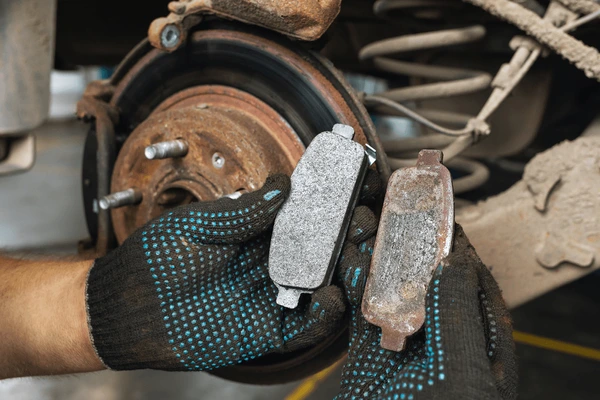Driving with worn brakes can significantly impact your safety and vehicle performance. Here are six critical issues that can arise when your brake pads are worn:
1. Extended Stopping Distance
Description: Worn brake pads reduce the effectiveness of your braking system, leading to longer stopping distances.
Impact: Increased stopping distance can make it harder to avoid collisions, especially in emergency situations or when driving at higher speeds.
Visual: An image showing a vehicle struggling to stop, with visual indicators like a longer distance between the vehicle and a stop sign.
2. Reduced Braking Performance
Description: As brake pads wear down, they lose their ability to generate sufficient friction with the rotors.
Impact: This results in a less responsive braking system, requiring more effort to slow down or stop the vehicle.
Visual: An image comparing a healthy brake system to one with worn pads, highlighting differences in performance.
3. Increased Brake Fade
Description: Worn brake pads are more susceptible to brake fade, a condition where the brakes lose their effectiveness due to excessive heat.
Impact: Brake fade can occur during intense braking situations, like downhill driving or heavy traffic, making the brakes feel soft or unresponsive.
Visual: A diagram showing the heat buildup in brakes and the resulting brake fade effect.
4. Grinding Noise
Description: When brake pads are excessively worn, metal components may come into contact with the brake rotors, causing a grinding noise.
Impact: This noise indicates severe wear and can signal that the brake rotors are being damaged, leading to costly repairs.
Visual: An image of a brake rotor with visible damage and a close-up of a grinding noise indicator.
5. Vibration or Pulsation in the Brake Pedal
Description: Worn brake pads can cause the brake pedal to vibrate or pulse when applied, often due to uneven wear or damaged rotors.
Impact: This can lead to a less stable braking experience and may indicate underlying issues with the brake system.
Visual: A close-up shot of a brake pedal with visible vibrations or pulsations, and a diagram showing the cause.
6. Pulling to One Side
Description: Unevenly worn brake pads or a stuck brake caliper can cause the vehicle to pull to one side during braking.
Impact: This can affect vehicle control and stability, making it harder to steer and maintain lane position.
Visual: An image of a vehicle pulling to one side during braking, with arrows indicating the direction of pull.
Conclusion
Driving with worn brakes poses significant risks, from increased stopping distances and reduced performance to more severe issues like brake fade and rotor damage. Regular maintenance and timely replacement of brake pads are essential for safe and reliable vehicle operation. If you notice any of these symptoms, it’s crucial to have your brakes inspected and serviced by a professional to ensure your safety on the road.

